26th August, 2025
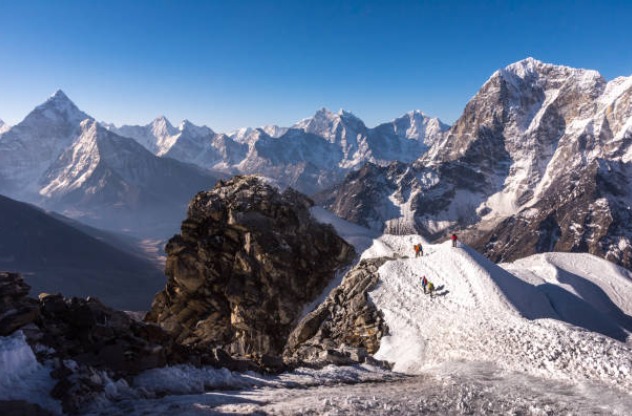
Jun 01, 2024
Lobuche Peak Climbing In February
- February Climbing Conditions on Lobuche Peak
- Winter Climbing Techniques for Steep Terrain
- Crampon and Ice Axe Maintenance for February Climbs
- Avalanche Risk Assessment in February
- Cold Weather Injuries: Prevention and Treatment
- Lobuche East vs. Lobuche West: February Route Comparison
- Permit Requirements and Regulations for February Climbs
- Hiring a Guide or Joining a Guided Expedition in February
- Physical Conditioning for Winter High-Altitude Climbing
- Crevasse Rescue Techniques in Deep Snow Conditions
- Winter Camping on Lobuche Peak: Tips and Strategies
- Staying Warm and Dry in Extreme Cold Conditions
- Dealing with Frostbite and Hypothermia on the Mountain
- Emergency Response Planning for Winter Climbing Accidents
- Communication Strategies in Remote Winter Environments
- Packing Essentials for Winter Climbing on Lobuche Peak
- Winter Navigation Techniques: GPS, Maps, and Compass Use
- Environmental Impact of Winter Climbing on Lobuche Peak Ecosystems
- Conclusion: Tips for a Successful Lobuche Peak Climb in February
- Lobuche Peak Climbing Packages
Climbing Lobuche Peak in February presents mountaineers with a unique blend of challenges and rewards amidst the serene winter landscape of the Everest region. Standing at 6,119 meters (20,075 feet), Lobuche Peak offers a thrilling ascent with panoramic views of some of the world's highest peaks, including Everest, Lhotse, and Nuptse.
February marks the heart of winter in Nepal, characterized by cold temperatures and clear skies, ideal for mountaineering expeditions. The journey typically begins with a flight from Kathmandu to Lukla, followed by a trek through picturesque Sherpa villages like Namche Bazaar and Pangboche. Acclimatization stops along the way help climbers adjust to high altitudes, crucial for preventing altitude sickness.
Base Camp preparations involve training sessions and gear checks before ascending to High Camp for final acclimatization and summit preparations. Climbers navigate icy trails and crevassed glaciers using crampons and ice axes, relying on ropes for safety during steep ascents and descents. The climb to Lobuche Peak's summit starts early in the morning to maximize favorable weather conditions and ensure a safe return before afternoon snowstorms.
Safety measures include avalanche awareness and emergency response planning, with climbers equipped with essential gear like avalanche transceivers, probes, and shovels. Experienced guides and support staff provide invaluable expertise, ensuring safe navigation and decision-making throughout the expedition.
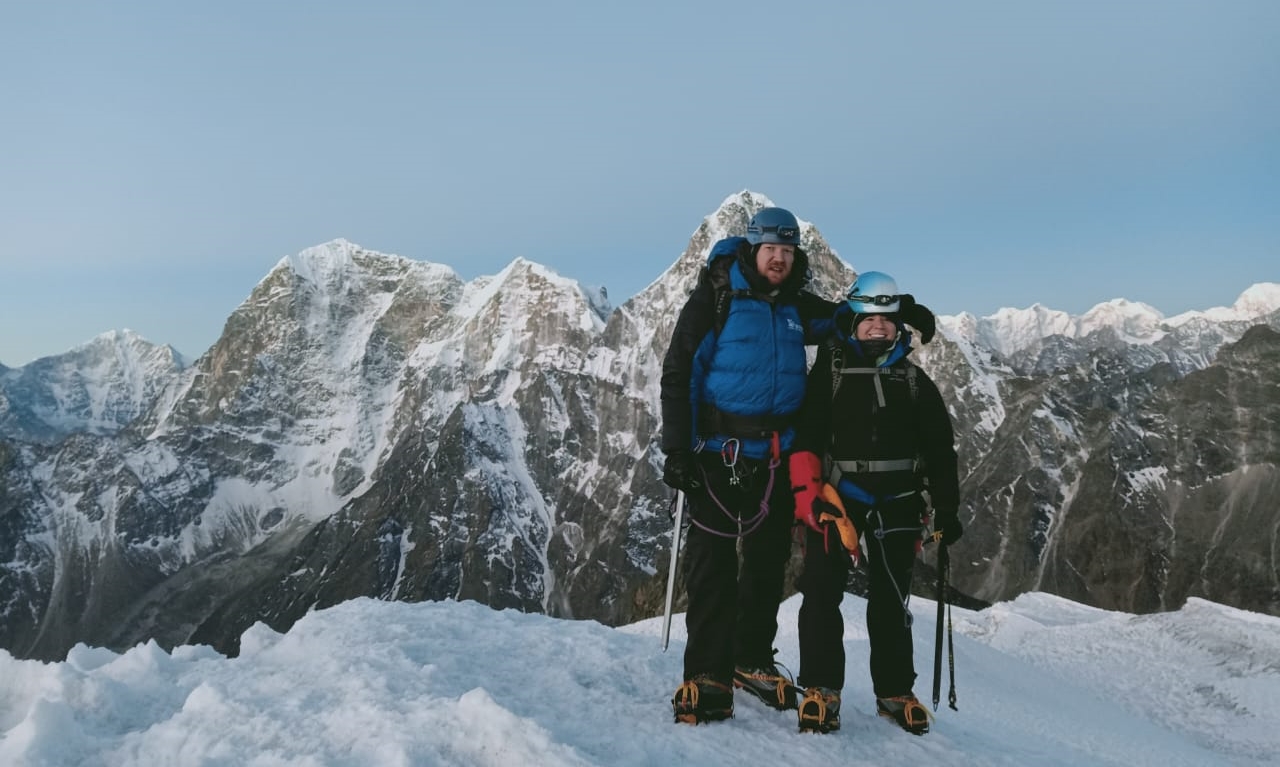
LOBUCHE PEAK CLIMBING
Lobuche East (6,119m/20,075ft), set in Nepal's stunning Khumbu on the Nepalese side of Everest.The best time to go trekking in Nepal is in Autumn (September-November) and in...
Winter climbing on Lobuche Peak requires specialized gear, including four-season tents, down or synthetic sleeping bags, and insulated clothing layers to withstand sub-zero temperatures. Nutrition and hydration are critical, with climbers consuming high-energy meals and staying hydrated with warm fluids to maintain peak physical performance.
Environmental considerations play a significant role in winter climbing, with climbers adhering to Leave No Trace principles by carrying out all waste and minimizing impact on fragile Himalayan ecosystems. Cultural interactions with Sherpa communities enrich the climbing experience, offering insights into local traditions and mountaineering heritage.
Climbing Lobuche Peak in February challenges climbers both physically and mentally, rewarding them with breathtaking views and a sense of accomplishment upon reaching the summit. The expedition concludes with a descent back to Base Camp, reflecting on the journey's highs and challenges while celebrating personal achievements amidst Nepal's awe-inspiring winter wilderness.
February Climbing Conditions on Lobuche Peak
February presents unique climbing conditions on Lobuche Peak, characterized by cold temperatures and stable weather windows ideal for mountaineering. Situated in the Everest region of Nepal, Lobuche Peak offers challenging yet rewarding ascents with stunning views of neighboring Himalayan giants like Everest and Lhotse.
Climbers can expect clear skies and crisp mountain air during February climbs, providing excellent visibility and minimizing weather-related risks. The ascent typically begins from Lukla after a scenic flight from Kathmandu, followed by a trek through snowy trails and picturesque Sherpa villages. Acclimatization stops at strategic points help climbers adjust to high altitudes, ensuring their readiness for the challenging summit push.
Base Camp preparations include gear checks and training sessions on winter climbing techniques and safety protocols. Climbers ascend to High Camp for final acclimatization before attempting the summit. Navigation through icy trails and crevassed glaciers requires proficiency in using crampons and ice axes, essential for maintaining stability and traction on steep terrain.

LOBUCHE PEAK SUMMIT RETURN BY HELICOPTER
A real climbing adventure that will leave you stunned at the beauty of the Himalayan Mountains. The Lobuche Peak Climbing expedition in the spectacular Khumbu region of Nepal has been ranked by Lonely...
Successful summit attempts usually start early in the morning to capitalize on stable snow conditions and minimize exposure to afternoon storms. Safety measures include avalanche awareness and emergency response planning, with climbers equipped with essential gear such as avalanche transceivers, probes, and shovels.
Winter Climbing Techniques for Steep Terrain
Winter climbing techniques for navigating steep terrain on Lobuche Peak in February require specialized skills and equipment to ensure safety and success. Climbers utilize crampons attached to their mountaineering boots, providing traction on icy slopes and minimizing the risk of slips and falls. Adjusting crampon points based on terrain steepness and snow consistency optimizes grip and stability during ascents and descents.
Ice axes serve multiple purposes, including self-arrest to stop a fall and anchoring for stability on steep terrain. Techniques such as front-pointing and French technique facilitate efficient movement on snow-covered slopes, conserving energy and maintaining balance. Using rope systems and harnesses for belaying and rappelling enhances safety during technical climbs and crevasse crossings.
Winter climbing also emphasizes snow and ice anchor placement for secure belay stations and emergency rappels. Practicing rope management skills and knots, such as the figure-eight and clove hitch, ensures efficient teamwork and communication among climbing partners. Regular training in winter climbing techniques enhances confidence and preparedness for navigating challenging terrain on Lobuche Peak and other high-altitude environments.

LOBUCHE PEAK EXPEDITION 14 DAYS
The Lobuche Peak Expedition is a 14-day trekking adventure that takes you to the heart of the Khumbu region in Nepal. It is a popular trekking peak in the Himalayas, with stunning views of the surroun...
Crampon and Ice Axe Maintenance for February Climbs
Maintaining crampons and ice axes is essential for safe and efficient climbing on Lobuche Peak in February, where sub-zero temperatures and icy conditions demand reliable equipment performance. Regular inspection and sharpening of crampon points ensure optimal traction and stability on snow and ice. Adjusting crampon fit to boots and testing bindings before climbs prevent equipment malfunctions and enhance user comfort and safety.
Ice axes require sharpening and corrosion protection to maintain blade effectiveness and durability in cold weather conditions. Checking axe shafts for cracks or damage and replacing worn-out components before climbs reduce risks of equipment failure during critical maneuvers on steep terrain.
Storing crampons and ice axes in protective covers or cases prevents damage to gear and maintains sharpness between climbs. Carrying spare parts, such as crampon straps and axe picks, ensures readiness for emergency repairs in remote mountain environments. Proper care and maintenance of climbing equipment contribute to safe and successful winter ascents on Lobuche Peak, optimizing performance and reliability in challenging conditions.
Avalanche Risk Assessment in February
Assessing avalanche risk is crucial for winter climbers on Lobuche Peak in February, where snow stability and terrain conditions can pose significant hazards. Understanding avalanche terrain features, such as steep slopes, convex rolls, and wind-loaded aspects, informs risk management strategies and route selection.
Monitoring weather forecasts and recent snowfall history provides valuable insights into avalanche conditions and potential instability. Recognizing signs of avalanche danger, including recent avalanches, cracking or collapsing snowpack, and rapid changes in temperature, prompts cautious decision-making and adjustments to climbing plans.
Using avalanche safety tools, such as avalanche transceivers, probes, and shovels, enhances preparedness for emergency response and rescue operations. Conducting snowpack stability tests, such as the shovel shear test and extended column test, assesses snow layer bonding and avalanche potential in specific terrain zones.
Implementing safe travel practices, such as traveling one at a time in avalanche-prone areas, minimizing exposure to steep slopes during peak avalanche conditions, and maintaining communication with climbing partners, mitigates avalanche risks during February climbs on Lobuche Peak. Collaborating with experienced guides and local authorities further enhances avalanche awareness and safety protocols, ensuring climbers enjoy a safe and successful expedition in the Himalayas.
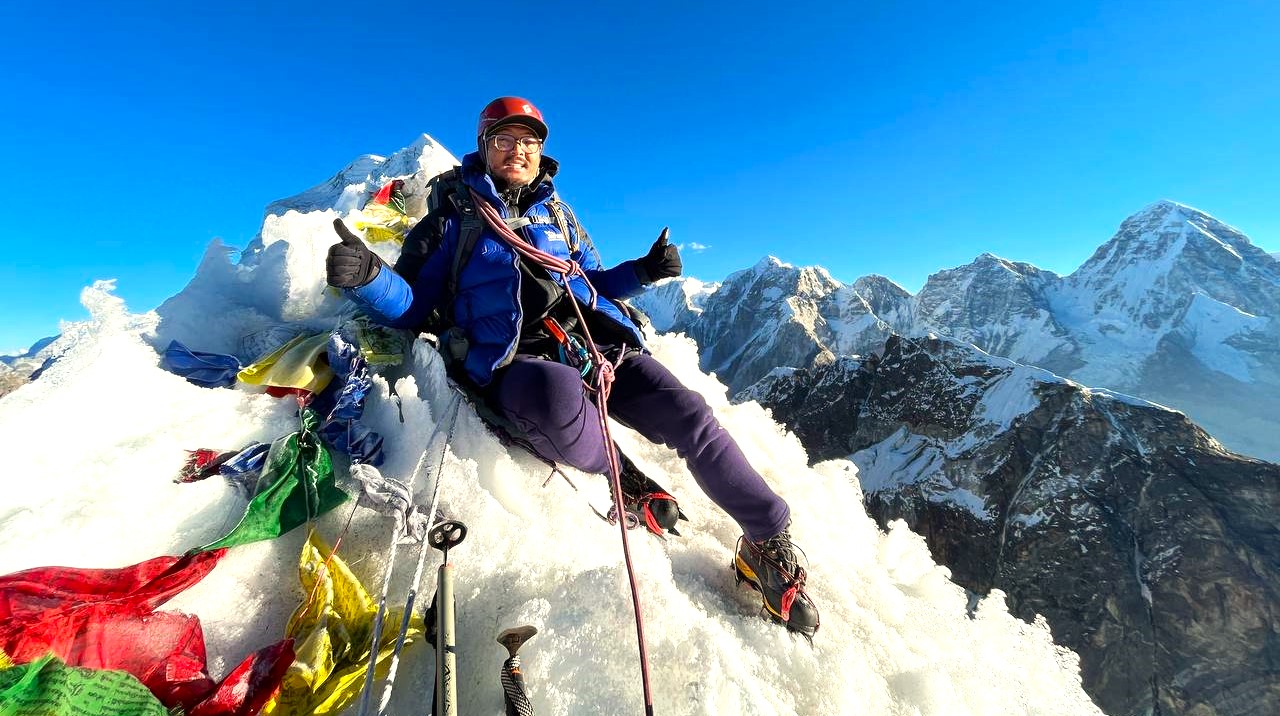
LOBUCHE PEAK EXPEDITION 15 DAYS
Lobuche Peak Expedition is a thrilling adventure that takes you to the heart of the Khumbu region in Nepal. The peak stands at an altitude of 6,119 meters and offers stunning views of the surrounding...
Cold Weather Injuries: Prevention and Treatment
Preventing and treating cold weather injuries is paramount for climbers tackling Lobuche Peak in February, where exposure to extreme temperatures and wind chill poses risks of frostbite, hypothermia, and other cold-related ailments. Layered clothing with moisture-wicking base layers, insulating mid-layers, and waterproof outer shells protect against heat loss and maintain core body temperature.
Insulated gloves, thermal socks, and headwear, such as balaclavas or neck gaiters, prevent frostbite on exposed skin surfaces like fingers, toes, ears, and nose. Monitoring skin color and sensation alerts climbers to early signs of frostbite, including numbness, tingling, and pale or waxy appearance.
Hypothermia prevention involves staying dry, avoiding overheating, and consuming high-energy foods and warm fluids to fuel metabolism and maintain internal body temperature. Recognizing symptoms, such as intense shivering, confusion, and drowsiness, prompts immediate rewarming measures, including removing wet clothing, applying dry layers, and sharing body heat with fellow climbers.
Carrying a comprehensive first aid kit with supplies for treating cold weather injuries, including chemical hand warmers, space blankets, and hot packs, enhances preparedness for emergency response. Evacuation protocols and communication strategies with guides and support teams facilitate timely medical care and ensure climbers' safety in remote mountain environments.
Training in cold weather survival skills and practicing self-care techniques, such as maintaining circulation through movement and minimizing moisture exposure, prepares climbers for the physical and mental demands of winter climbing on Lobuche Peak. Prioritizing safety, preparation, and teamwork optimizes enjoyment and success in challenging winter conditions in the Everest region of Nepal.
Lobuche East vs. Lobuche West: February Route Comparison
Lobuche East and Lobuche West present distinct route options for climbers in February, each offering unique challenges and rewards in the Everest region of Nepal. Lobuche East, at 6,119 meters (20,075 feet), requires technical climbing skills and offers a challenging ascent with steep sections and crevassed glaciers. The route typically begins from Lobuche Base Camp, with acclimatization stops at High Camp before summit attempts.
Conversely, Lobuche West, standing at 6,145 meters (20,161 feet), provides a less technical climb compared to Lobuche East but includes a longer approach through the Lobuche Glacier. Climbers navigate moderate slopes and crevasses, enjoying panoramic views of Everest and the Khumbu Valley along the way.
Choosing between Lobuche East and Lobuche West depends on climbers' skill levels, objectives, and preferences for technical difficulty and scenery. Both routes require proper acclimatization, winter climbing techniques, and safety measures to mitigate risks in February's cold and variable weather conditions.
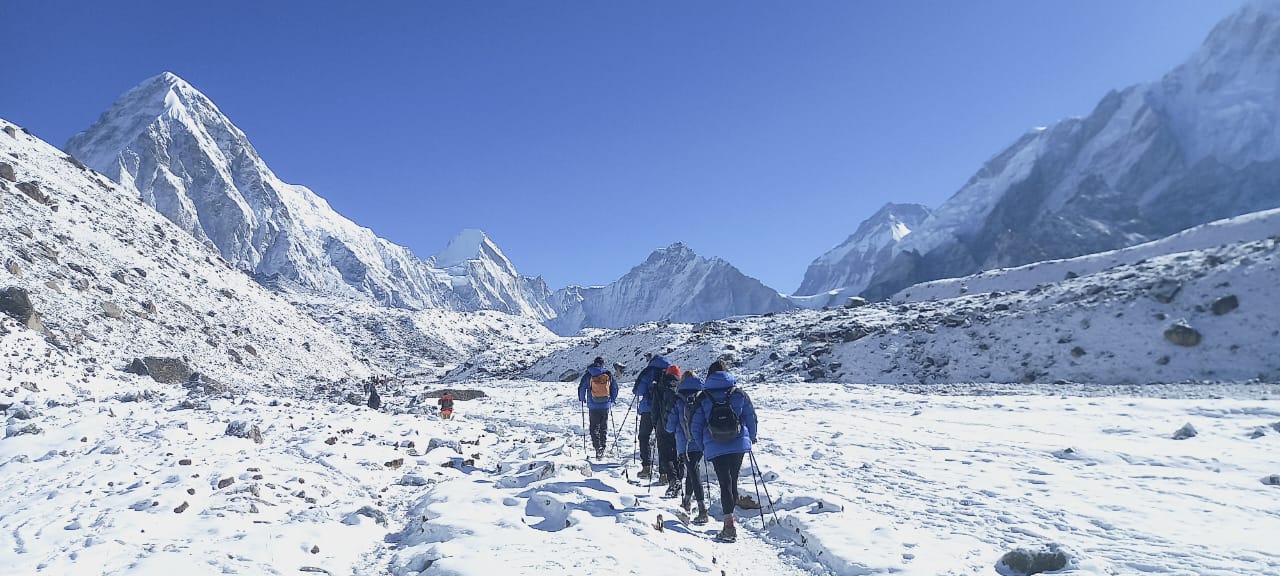
MERA AND ISLAND PEAK CLIMBING
Embark on a thrilling mountaineering adventure like no other with the Mera and Island Peak Climbing expedition crafted by We Sherpa Expedition and Trekking. This exclusive package is designed for adve...
Permit Requirements and Regulations for February Climbs
Permit requirements and regulations for climbing Lobuche Peak in February are essential considerations for ensuring legal compliance and safety in the Everest region. Climbers must obtain permits through authorized agencies, such as the Nepal Mountaineering Association (NMA) or local trekking agencies, to access Lobuche Peak and surrounding areas.
Permits typically include climbing fees, national park entry fees, and provisions for waste management and environmental conservation. Regulations govern group sizes, waste disposal practices, and adherence to Leave No Trace principles to minimize environmental impact and preserve fragile Himalayan ecosystems.
Local regulations also prioritize safety by requiring climbers to register their itineraries with park authorities and carry adequate insurance coverage for emergency medical evacuation and rescue operations. Hiring accredited guides or joining guided expeditions ensures compliance with permit regulations and enhances safety through experienced leadership and logistical support.
Understanding permit requirements and regulations facilitates responsible climbing practices and supports sustainable tourism initiatives in the Everest region. Collaboration with local communities and authorities promotes cultural preservation and environmental stewardship, ensuring future generations can enjoy the natural beauty and adventure of Lobuche Peak.
Hiring a Guide or Joining a Guided Expedition in February
Hiring a guide or joining a guided expedition in February enhances safety, navigation, and overall experience for climbers tackling Lobuche Peak in Nepal's winter season. Experienced guides offer invaluable expertise in route planning, weather interpretation, and risk management, optimizing climbers' chances of a successful summit bid.
Guided expeditions provide logistical support, including accommodation arrangements, meals, and transportation to and from Kathmandu. Guides facilitate acclimatization schedules, coordinate porter services for gear transport, and manage emergency response protocols in remote mountain environments.
Choosing a reputable guide or expedition company involves researching qualifications, client testimonials, and adherence to safety standards set by international mountaineering associations. Guides with local knowledge of the Everest region enrich cultural interactions with Sherpa communities and provide insights into mountaineering traditions and environmental conservation efforts.
Guided expeditions also foster camaraderie among climbers, creating a supportive team environment that enhances motivation and morale during challenging climbs. Collaborating with guides ensures compliance with permit regulations, enhances navigation through unfamiliar terrain, and promotes responsible travel practices in Nepal's Himalayas.
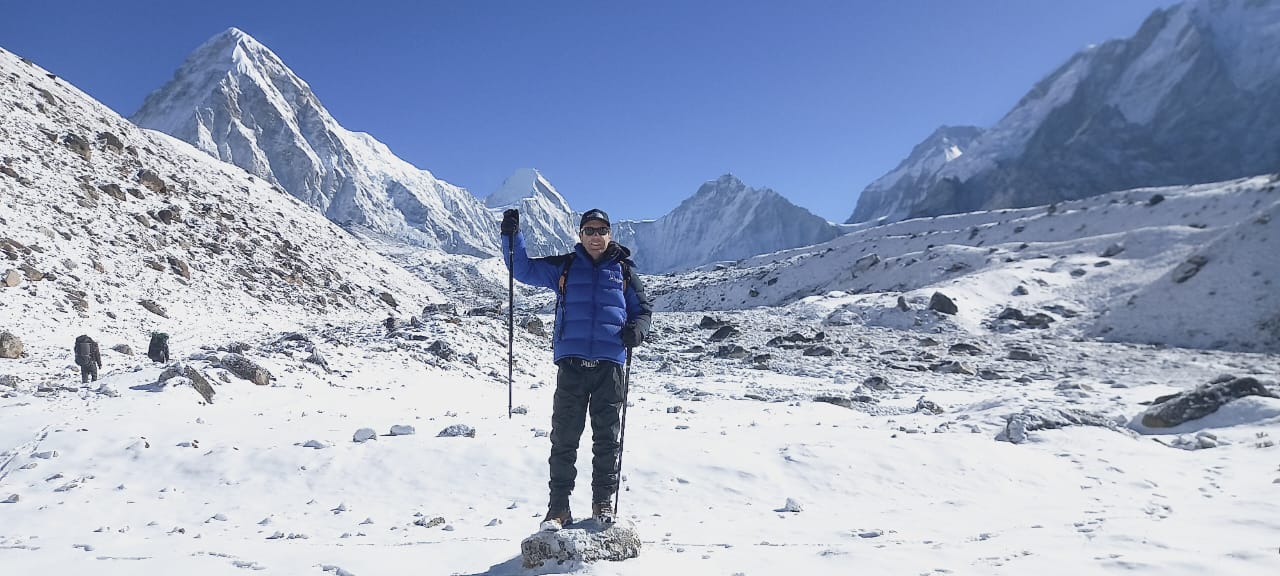
ISLAND AND LOBUCHE PEAK CLIMBING
Lobuche and Island Peak combo climbing expedition is a thrilling adventure that offers a unique opportunity to conquer two popular peaks in the Everest region of Nepal. Lobuche Peak (6,119m) and Islan...
Physical Conditioning for Winter High-Altitude Climbing
Physical conditioning for winter high-altitude climbing on Lobuche Peak in February requires comprehensive preparation to withstand rigorous demands of cold weather, high altitude, and technical terrain. Training focuses on cardiovascular endurance, muscular strength, and flexibility to sustain prolonged exertion and acclimatization.
Endurance training includes hiking, running, and cycling to build cardiovascular fitness and improve oxygen utilization efficiency at high altitudes. Strength training targets core muscles, legs, and upper body for stability, balance, and power required for climbing with heavy packs and navigating steep slopes.
Flexibility exercises, such as yoga and stretching routines, enhance joint mobility and reduce the risk of muscle strains and injuries during climbs. Mental conditioning techniques, including visualization, meditation, and stress management, prepare climbers for the physical and psychological challenges of winter mountaineering.
Simulated altitude training in hypoxic environments or using altitude training masks acclimates the body to reduced oxygen levels, enhancing performance and adaptation to high-altitude conditions. Gradual acclimatization during climbs includes strategic rest days, hydration, and nutrition to minimize altitude sickness symptoms and optimize climbing efficiency.
Consulting with healthcare professionals and experienced mountaineers ensures personalized training programs tailored to individual fitness levels and climbing objectives. Adequate rest and recovery between training sessions support muscle repair and adaptation to physical exertion at high altitudes.
Crevasse Rescue Techniques in Deep Snow Conditions
Crevasse rescue techniques are essential skills for navigating deep snow conditions and crevassed glaciers during winter climbs on Lobuche Peak in February. Climbers use rope systems and harnesses for team travel and safety, with each member trained in self-rescue and assisting teammates in crevasse falls.
Practicing rope skills, such as tying knots, creating anchors, and performing rope ascension and descent, prepares climbers for emergency scenarios involving crevasse rescues. Assessing snow bridges and visible crevasse hazards informs route selection and safe travel practices to avoid potential falls and accidents.
Carrying essential rescue equipment, including pulleys, prusik cords, ice screws, and mechanical ascenders, facilitates efficient extraction and evacuation of injured climbers from crevasses. Utilizing snow probes and avalanche transceivers enhances search and rescue capabilities in deep snow conditions and low-visibility environments.

CHULU FAR EAST PEAK CLIMBING
Are you looking for adventure, natural beauty, magnificent snow-capped peaks, and unique cultural experience?This Peak Climbing will give you all the thrills, variety, and the adrenalin rush as you cl...
Team communication and coordination during crevasse rescues prioritize safety and minimize response times to expedite medical care and evacuation. Regular training drills and scenario simulations prepare climbers for real-world emergencies, fostering confidence and readiness to handle unforeseen challenges on Lobuche Peak and other high-altitude climbs.
Mastering crevasse rescue techniques underscores the importance of teamwork, preparation, and effective communication in mitigating risks and ensuring safe passage through crevassed terrain. Collaborating with experienced guides and practicing emergency response protocols enhances climbers' abilities to navigate deep snow conditions and enjoy a successful ascent of Lobuche Peak in February.
Winter Camping on Lobuche Peak: Tips and Strategies
Winter camping on Lobuche Peak in February requires meticulous planning and preparation to endure extreme cold and challenging mountain conditions. Choosing a sheltered campsite with natural windbreaks and solid ground minimizes exposure to harsh weather and enhances comfort during overnight stays.
Setting up durable four-season tents with double-wall construction provides insulation against cold temperatures and wind chill. Using insulated sleeping pads and down or synthetic sleeping bags rated for sub-zero temperatures ensures warmth and restful sleep despite freezing conditions.
Storing gear and clothing in waterproof stuff sacks or dry bags protects against moisture and maintains dryness in critical survival equipment. Organizing campsite layouts with designated cooking areas and waste disposal sites promotes safety, hygiene, and environmental stewardship in remote mountain environments.
Regular maintenance of camping equipment, including stove fuel checks and snow melting techniques for water supply, supports self-sufficiency and sustainability during winter expeditions. Adhering to Leave No Trace principles by packing out all waste and minimizing human impact on fragile ecosystems preserves the pristine beauty of Lobuche Peak for future climbers.
Staying Warm and Dry in Extreme Cold Conditions
Staying warm and dry in extreme cold conditions is essential for climbers tackling Lobuche Peak in February, where temperatures can plummet well below freezing. Layered clothing systems with moisture-wicking base layers, insulating mid-layers like fleece or down jackets, and waterproof outer shells protect against heat loss and wind chill.
Insulated gloves, thermal socks, and headwear, such as balaclavas or neck gaiters, prevent frostbite on exposed skin surfaces like fingers, toes, ears, and nose. Monitoring skin color and sensation alerts climbers to early signs of frostbite, including numbness, tingling, and pale or waxy appearance.
Managing body heat through layer adjustments and ventilation maintains core temperature and prevents overheating during strenuous climbs and rest breaks. Dry clothing changes and shelter from wind and precipitation reduce the risk of hypothermia, a potentially life-threatening condition caused by prolonged exposure to cold temperatures.
Carrying spare clothing layers and emergency blankets in backpacks ensures readiness for sudden weather changes and unexpected overnight stays. Consuming high-energy snacks and warm fluids, including hot tea or soup, replenishes calories and hydrates the body in frigid mountain environments.

YALA PEAK CLIMBING
Don’t let the height frighten you (5520m). This is a non-technical climb that will afford views for miles and miles in the Langtang region of Nepal. From the summit, you can see Mt. Sishapangma...
Dealing with Frostbite and Hypothermia on the Mountain
Dealing with frostbite and hypothermia requires prompt recognition, prevention, and treatment strategies for climbers on Lobuche Peak in February. Frostbite prevention involves wearing insulated clothing layers, including gloves, socks, and headwear, to protect against extreme cold and wind chill.
Monitoring skin sensation and color changes, such as pale or discolored patches, alerts climbers to early signs of frostbite, prompting immediate rewarming measures. Gently rewarming affected areas with body heat or warm water immersion avoids further tissue damage and promotes circulation and sensation recovery.
Hypothermia prevention focuses on maintaining core body temperature through layered clothing, dry shelter, and high-energy food consumption to fuel metabolism and heat production. Recognizing hypothermia symptoms, including intense shivering, confusion, and drowsiness, prompts immediate rewarming measures and evacuation planning for severe cases.
Carrying a comprehensive first aid kit with supplies for treating cold-related injuries, including chemical hand warmers, space blankets, and emergency medical tools, enhances preparedness for remote mountain emergencies. Collaborating with guides and climbing partners to monitor each other's health and well-being promotes teamwork and safety during winter climbs on Lobuche Peak.
Emergency Response Planning for Winter Climbing Accidents
Emergency response planning is critical for winter climbing accidents on Lobuche Peak, where remote and harsh conditions can pose significant challenges to rescue operations. Developing a comprehensive emergency action plan involves assessing risks, establishing communication protocols, and equipping climbers with essential rescue gear and medical supplies.
Carrying satellite phones or two-way radios enables real-time communication with base camps, guides, and emergency response teams to coordinate rescue efforts and provide accurate location information. Registering climbing itineraries with local authorities and monitoring weather forecasts enhance preparedness for changing conditions and potential emergencies.
Practicing emergency response drills, including crevasse rescue techniques and casualty evacuation procedures, prepares climbers for swift and effective crisis management in challenging terrain. Conducting mock scenarios and simulating response protocols reinforce teamwork and decision-making skills under stress.
Implementing evacuation procedures, such as helicopter rescue coordination and ground evacuation routes, ensures timely medical care and evacuation of injured climbers from remote mountain locations. Maintaining updated first aid certifications and emergency contact information for local hospitals and rescue services supports efficient response to medical emergencies.

PISANG PEAK CLIMBING
Do you have the urge to go higher and test your endurance? Take a 6091m detour off the beaten track to a pyramid-shaped peak north of Pisang and Annapurna II on the Annapurna Circuit trail. ...
Communication Strategies in Remote Winter Environments
Communication strategies in remote winter environments on Lobuche Peak require reliable technology, clear protocols, and effective teamwork to ensure safety and coordination during climbs. Carrying satellite phones or radios with spare batteries facilitates consistent communication with base camps, guides, and support teams, even in areas with limited cell service.
Establishing regular check-in times and emergency contact procedures enhances accountability and situational awareness among climbing partners and support staff. Using pre-established codes or signals for emergency situations, weather updates, and route progress informs decision-making and enhances response times during critical incidents.
Maintaining open channels of communication through group meetings and daily briefings fosters collaboration and cohesion among climbing teams. Sharing navigational waypoints, weather forecasts, and logistical updates promotes efficiency and safety throughout the expedition.
Cultural sensitivity and respect for local traditions and communication styles strengthen relationships with Sherpa communities and facilitate mutual understanding in multicultural mountain environments. Collaborating with experienced guides and interpreters enhances communication effectiveness and enriches the climbing experience on Lobuche Peak.
Adapting communication strategies to environmental conditions and technological capabilities ensures climbers can navigate remote winter environments safely and enjoyably while promoting responsible travel practices and environmental stewardship in Nepal's Himalayas.
Packing Essentials for Winter Climbing on Lobuche Peak
Packing essentials for winter climbing on Lobuche Peak in February requires careful consideration of specialized gear and clothing to withstand harsh mountain conditions. Layered clothing systems with moisture-wicking base layers, insulating mid-layers like down jackets, and waterproof outer shells protect against cold and wind chill.
Essential gear includes four-season tents, down or synthetic sleeping bags rated for sub-zero temperatures, insulated gloves, thermal socks, and headwear like balaclavas or neck gaiters to prevent frostbite. Carrying crampons, ice axes, and ropes for navigating icy terrain ensures stability and safety during ascents and descents.
Additional items include high-energy snacks, hydration systems or insulated water bottles, first aid kits with cold weather injury supplies, and navigation tools like GPS devices, maps, and compasses. Personal items such as sunscreen, sunglasses, and toiletries contribute to comfort and hygiene during extended climbs.
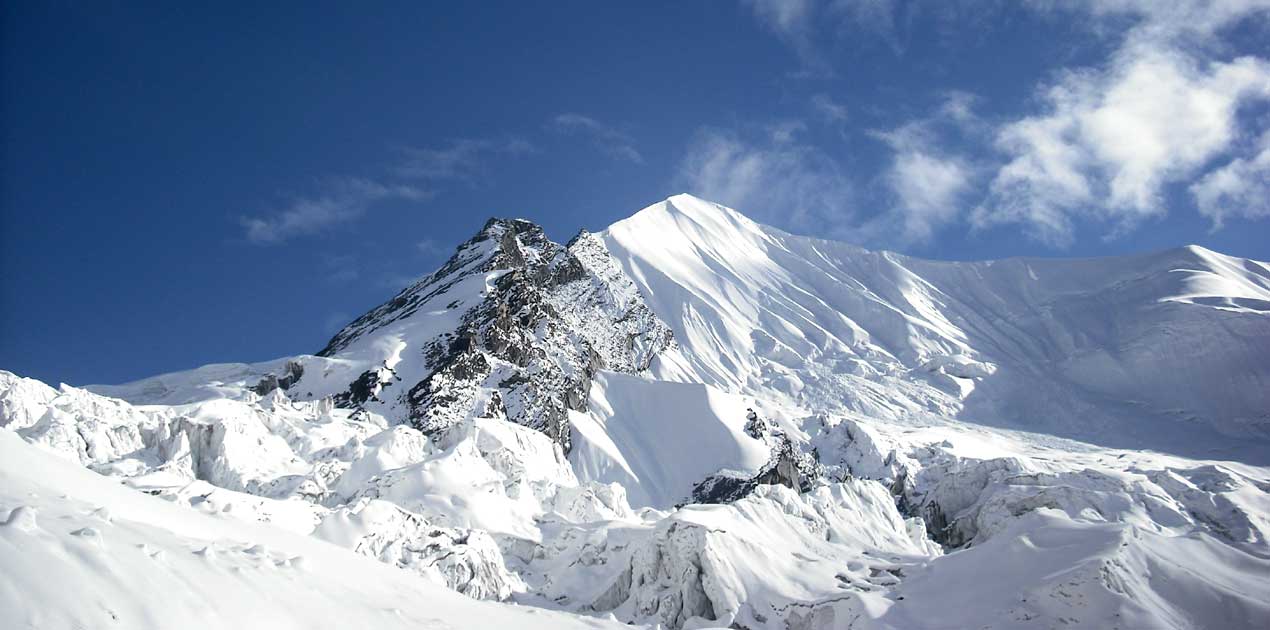
PACHERMO PEAK CLIMBING
Believe in yourself! You have what it takes to summit this beautiful peak in the remote Rolwaling district in the northeast of Nepal – near the Tibetan border. It is physically demanding, but with som...
Winter Navigation Techniques: GPS, Maps, and Compass Use
Winter navigation techniques using GPS, maps, and compasses are essential skills for climbers navigating Lobuche Peak's complex terrain in February. GPS devices provide accurate coordinates and track progress in low-visibility conditions or unfamiliar terrain, supporting route planning and emergency response.
Topographic maps and compasses assist in orienting climbers to surrounding landmarks, identifying terrain features, and navigating off-trail or in dense snow cover. Understanding map symbols, scales, and contour lines enhances accuracy in route selection and safety during winter climbs.
Cross-referencing GPS data with map readings confirms location and validates navigation decisions, reducing reliance on electronic devices and conserving battery life. Regular map updates and route planning consultations with experienced guides optimize navigation efficiency and minimize risks of getting lost or disoriented.
Practicing navigation techniques in diverse weather conditions and simulated scenarios prepares climbers for real-world challenges and enhances confidence in backcountry travel. Collaboration with climbing partners and local guides fosters teamwork and mutual support, ensuring safe and successful navigation during winter climbs on Lobuche Peak.
Environmental Impact of Winter Climbing on Lobuche Peak Ecosystems
The environmental impact of winter climbing on Lobuche Peak ecosystems underscores the importance of sustainable practices and responsible stewardship in Nepal's Himalayas. Climbing activities can disrupt fragile habitats and wildlife, necessitating measures to minimize ecological footprint and preserve natural resources.
Adhering to Leave No Trace principles, including packing out all waste and minimizing soil disturbance, mitigates environmental degradation and maintains pristine landscapes for future generations. Using designated campsites and following established trekking routes reduce vegetation damage and soil erosion in sensitive mountain environments.
Conserving water resources through efficient use and waste management practices, such as melting snow for drinking water and limiting detergent use near water sources, supports ecosystem health and biodiversity conservation. Avoiding wildlife disturbances and respecting local cultural traditions promote harmony between climbers and indigenous communities.
Collaboration with local conservation organizations and community initiatives fosters environmental education and sustainable tourism practices in the Everest region. Participating in volunteer cleanup efforts and supporting reforestation projects contribute to long-term environmental sustainability and climate resilience in Nepal's Himalayan ecosystems.

THORONG PEAK CLIMBING
Thorong Peak Climbing requires that you are reasonably fit and have a burning desire to see some of the most spectacular mountain scenery in the Annapurna region of Nepal. Besides climbing to 6144m, y...
Conclusion: Tips for a Successful Lobuche Peak Climb in February
Achieving a successful climb of Lobuche Peak in February requires meticulous planning, physical preparation, and adherence to safety protocols amidst challenging winter conditions. Start by researching and selecting experienced guides or reputable expedition companies familiar with winter mountaineering in the Everest region.
Prepare for the cold with layered clothing systems, insulated gear, and adequate nutrition and hydration supplies to sustain energy and prevent cold-related injuries. Practice winter navigation techniques using GPS, maps, and compasses to navigate snow-covered terrain and ensure route accuracy.
Acclimatize gradually to high altitudes to reduce the risk of altitude sickness and optimize climbing performance during summit attempts. Maintain open communication with climbing partners, guides, and support teams to monitor weather updates and coordinate emergency response plans.
Respect environmental regulations and cultural sensitivities by minimizing waste, supporting local communities, and leaving no trace of your visit. Embrace the journey with patience, perseverance, and appreciation for the natural beauty and challenges of climbing Lobuche Peak in February.
By prioritizing safety, sustainability, and teamwork, climbers can maximize their chances of a successful ascent and unforgettable experience in Nepal's majestic Himalayas.
Lobuche Peak Climbing Packages
Lobuche Peak Summit Return By Helicopter
Lobuche Peak Expedition 14 Days
Lobuche Peak Expedition 15 Days
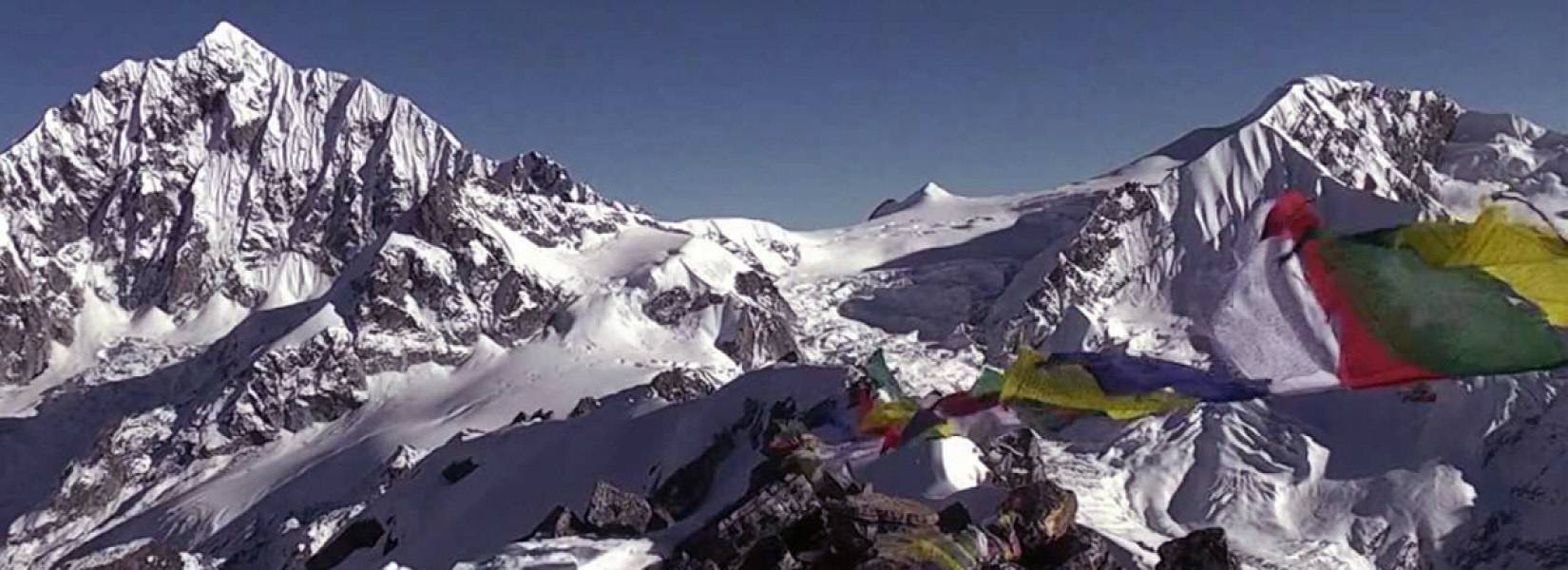
LARKE PEAK CLIMBING
Can there be any greater feeling than standing at the top of a mountain?This climb will test your endurance and determination and give you a true sense of achievement. The rewards are numerous. Firstl...
Any Questions? Let Us Know.
Recent Posts
17th June, 2025


















